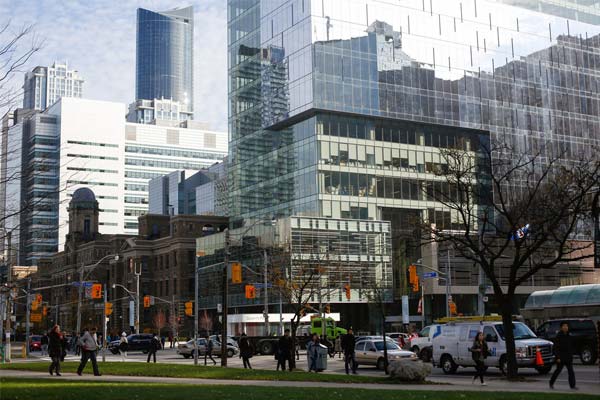
(photo by Makeda Marc-Ali)
Understanding U of T’s expanded partnership with MaRS
Published: September 3, 2015
The University of Toronto announced on September 3 an expanded partnership with MaRS which will provide much-needed laboratory space for researchers.
The partnership also takes advantage of the dynamic networks MaRS has developed to support student entrepreneurship and the translation of U of T discoveries into new therapies.
It will become home to several of the recently established inter-faculty research centres, including Medicine by Design and the Ted Rogers Centre for Heart Research. Overall, it will add more than 160,000 square feet of space to U of T’s vast research enterprise.
Solving the urgent demand for more U of T research facilities
This partnership solves an urgent need for state-of-the-art lab space to support the burgeoning growth in research, most acutely in the area of medical research.
“This is a big step in our overall commitment to support our students, faculty and researchers in their work solving the most complex and devastating diseases of our time,” says Scott Mabury, Professor & Vice-President of Operations for the University of Toronto.
“U of T has had great success in attracting significant philanthropic and government support for strategic efforts at solving serious health problems. This reflects the power and potential arising from the creative efforts of our faculty, students and staff. We need top-of-the-line research lab space to continue realizing that potential.”
The design of these new research facilities will closely follow the wildly successful labs in the Donnelly Centre for Cellular and Biomedical Research. The move into the MaRS West Tower offers the same opportunity for collaborative research space, but comes much faster and at less cost than any alternative.
Leveraging Toronto’s biomedical hub
MaRS is an ideal location. It is across the street from the U of T, adjacent to the hospital corridor and right in the middle of North America’s third-largest biomedical cluster. This partnership allows U of T to leverage this powerful centre of innovation and entrepreneurship.
“This is an exciting move for medical research at the University of Toronto,” says Faculty of Medicine Dean Trevor Young. “It allows us to capitalize on the dynamic networks of biomedical leaders at MaRS.”
Providing a home to new research initiatives
MaRS will be home to the Ted Rogers Centre for Heart Research, which was established thanks to an unprecedented donation of $130 million from the Rogers family – the largest monetary gift ever made to a Canadian health care initiative. The new tower will also host the Medicine by Design initiative, set to become a leading centre in regenerative medicine at the University of Toronto with the federal government committing $114-million for this project through the Canada First Research Excellence Fund.
It also provides a home to two existing research organizations: the U of T-based Centre for Commercialization of Regenerative Medicine, a not-for-profit organization supporting the development of stem cell- and biomaterials-based products and therapies, and the university’s advanced computing and data analytics centre, ARCNet.
“In addition, we’ll have the opportunity to move some of our fundamental science laboratories to MaRS, specifically in the areas of infectious diseases, drug discovery and regenerative medicine. This is a great opportunity to help the basic science sector thrive. Our researchers will benefit from working closely with the other great organizations at MaRS, and they’ll be able to contribute their expertise in the design of new therapies,” says Young.
20 per cent equity share in the MaRS West Tower
The university of Toronto is investing in a 20 per cent equity share in the west tower of MaRS. The university will have the use of four floors of the new building for health research, biomedical manufacturing and the commercialization of key scientific discoveries.
U of T is one of the four founding partners of MaRS, including the city, the province, and the federal government. Through this investment, the university will be a full partner in making this research tower a success.
Big step in a larger process of renewal for U of T research space
“This acquisition will provide us with time to plan strategically the renewal of our existing medical science research space, including the site currently housing our Banting & Best Centre for Innovation & Entrepreneurship.” says Mabury. “These buildings are past their prime but are brimming with entrepreneurial innovation, as well as an energetic community of almost two dozen student spinout companies, two centres of commercialization, our Innovations and Partnership Office and the Impact Centre, one of U of T’s nine campus-led accelerators.”



